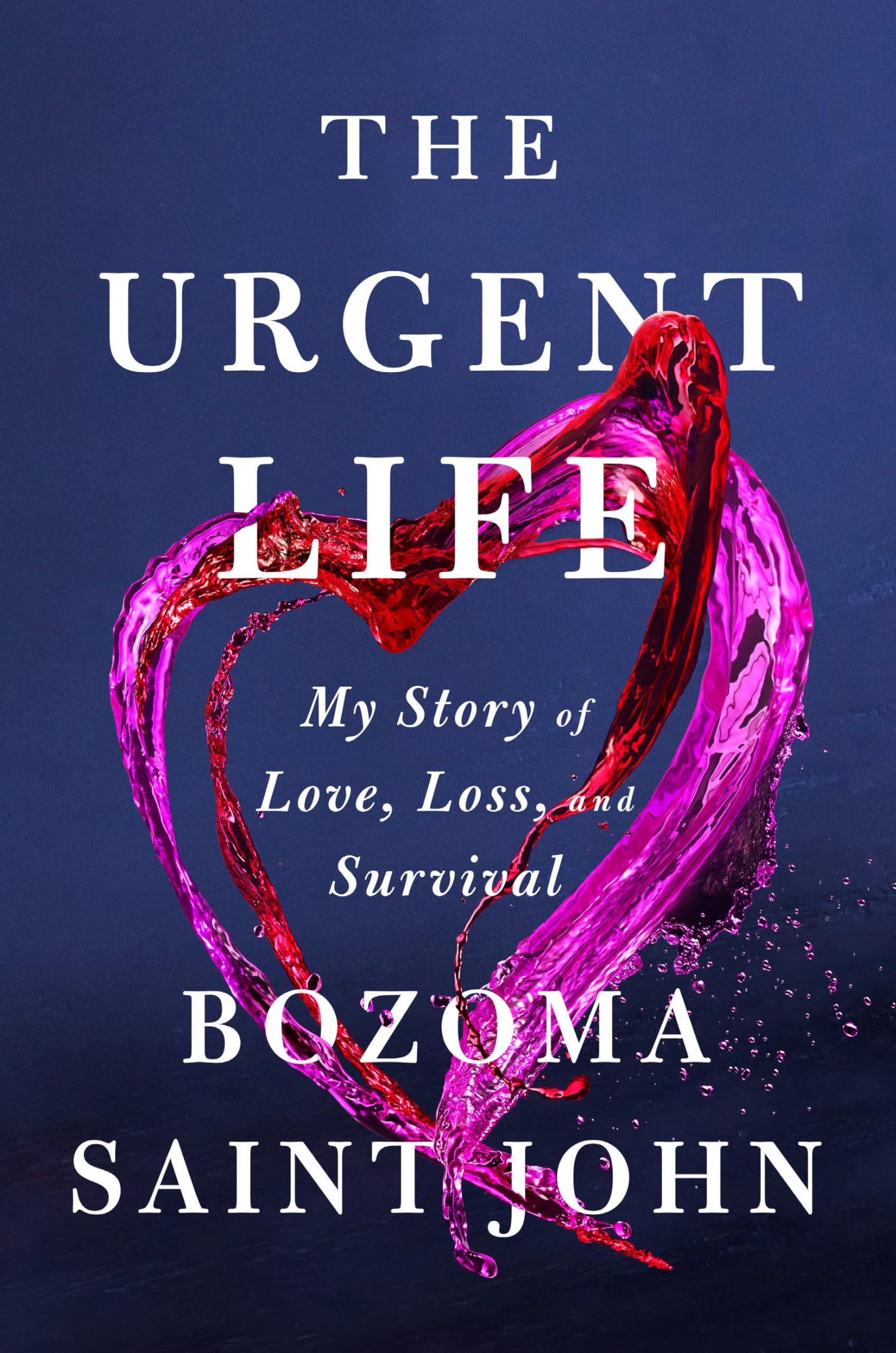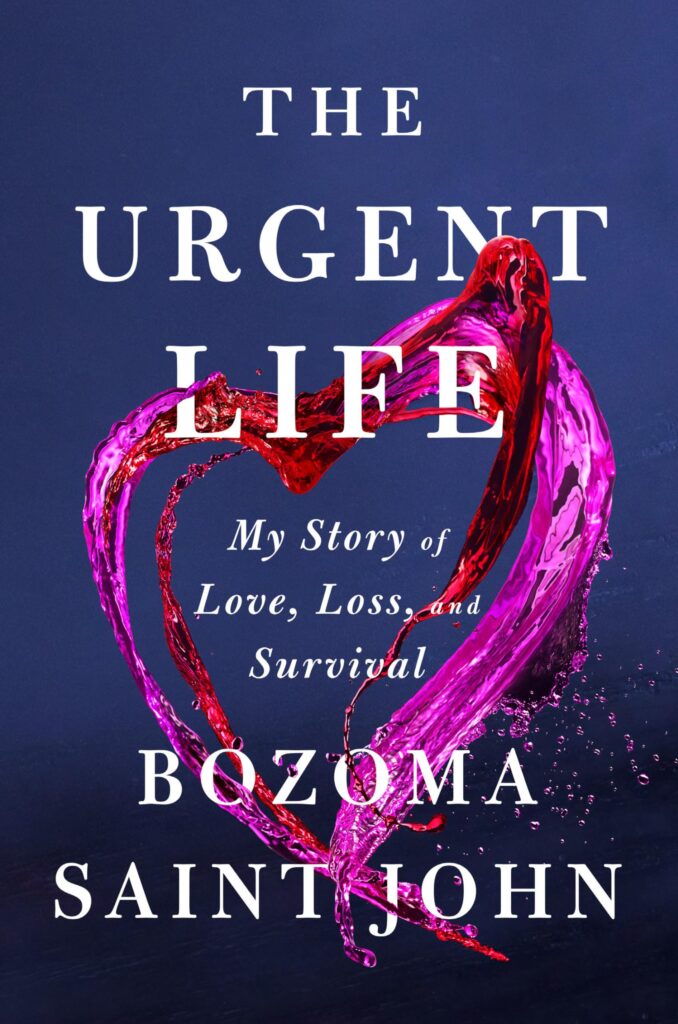Life & Pivot
Go where your heart leads you for now.
Some of our Favourites
What Bozoma Saint John Taught Me About Systems, Soul, and Showing Up Fully Some books teach you something. Others crack you open and rebuild you. The Urgent Life by Bozoma Saint John did both with these creative CEO business lessons. Initially, I read it as a woman, a systems strategist, and a creative CEO, and […]

Read More
What Bozoma Saint John Taught Me About Systems, Soul, and Showing Up Fully

Some books teach you something. Others crack you open and rebuild you. The Urgent Life by Bozoma Saint John did both with these creative CEO business lessons.
Initially, I read it as a woman, a systems strategist, and a creative CEO, and every page felt like a wake-up call. Not just about grief, but about how much of our work is built on urgency that isn’t ours, pressure that isn’t healthy, and systems that don’t actually serve us.
However, after losing her husband to cancer at just 34, Saint John discovered what she calls “the freedom of urgency” — not the panic-inducing urgency of deadlines, but the profound clarity that comes when you realize how precious time truly is.
As a result, creative CEO business lessons reminded me that love is the strategy. Clarity is the vehicle. And surviving? That’s not the goal — thriving is.
Therefore, I pulled five of the most soul-shifting creative CEO business lessons and translated them into how I show up for my clients, my business, and myself. If you’ve been building on fumes, stuck in chaos, or questioning whether it’s all worth it, this is for you.

1. Urgency Isn’t Panic — It’s Presence.
What the book says:
Bozoma doesn’t glamorize urgency. She reframes it. “Urgency isn’t about constant motion,” she writes. “It’s about being fully present in the moments that matter.” Urgency isn’t about rushing—it’s about being radically clear on what matters now and moving with heart, not fear.
How I’m applying it:
Consequently, I restructured my week to include more white space. I automated the noise. I built systems that help me prioritize what matters this season, not what Instagram says should matter. I even created what Saint John calls “presence checkpoints” throughout my client journeys—places where I intentionally slow down to be fully there.
How you can apply it:
Similarly, audit your to-do list. Ask: “Is this urgent because it’s aligned — or because I’m afraid?“
Build a simple “priority filter” system (Notion, journal, whatever works) and commit to 3 urgent on-purpose actions per week. That’s it. As Saint John would say, “Choose what deserves your urgency, don’t let urgency choose you.“

2. Grief and Growth Walk Together.
What the book says:
Furthermore, Bozoma’s story is steeped in loss — and yet, she doesn’t treat grief like a detour. It’s part of the path. She writes, “Grief doesn’t diminish your capacity for joy; it expands it.” She makes space for it while still showing up, building, and healing.
How I’m applying it:
As a result, I stopped pretending that hard seasons don’t impact my workflow. I built client systems that hold space for my humanity — buffer time, flexible launch windows, “grace weeks.” And I started talking about grief in my brand. Because we all carry it. As Saint John says, “Your grief is evidence of your courage to love deeply.”
How you can apply it:
Likewise, you can take inventory of where you are forcing yourself to “just push through” when you actually need space.
Then adjust your ops — even one automation or boundary helps. Build systems that let you show up human, not superhuman. In Saint John’s words: “The goal isn’t to overcome grief, but to carry it with grace while continuing to build.”

3. Clarity is the Most Urgent Strategy.
What the book says:
Moreover, Bozoma made choices — hard ones — with incredible clarity. “When time feels finite,” she writes, “you stop wasting it on things that don’t matter.” That clarity gave her the urgency to act on purpose, not react out of panic.
How I’m applying it:
I do weekly “clarity check-ins” where I review what actually moved the needle and what just drained me. I also trimmed services that felt like noise — and leaned harder into strategy and systems, because that’s where I thrive and deliver. Saint John’s framework of “What deserves my yes?” became my filter for every opportunity.
How you can apply it:
Create your own Clarity Dashboard. Track 3 things weekly:
- What gave me energy?
- What drained me?
- What results came from what I focused on?
That’s your roadmap. Your backend should support that clarity, not bury it. As Saint John says, “Clarity isn’t just knowing what to do—it’s knowing why you’re doing it.“

4. Love is a Legit Business Strategy.
What the book says:
In addition to strategic clarity, Bozoma’s whole world is built on love—romantic, maternal, communal. “Love isn’t a luxury,” she insists. “It’s the foundation.” And she shows that love isn’t soft or side-salad energy. It’s the fuel. It’s the mission.
How I’m applying it:
Every system I build now has one question baked in: Does this reflect the way I want my people to feel?
That’s how I design onboarding flows, automate client touchpoints, and create supportive timelines — with love at the center, not as an afterthought. I’ve started what Saint John calls “emotional mapping”—identifying where my clients might feel vulnerable and designing systems that meet them there with care.
How you can apply it:
Choose one part of your client journey this week (inquiry, delivery, offboarding). Ask: “How can I infuse care and clarity here?”
Then set up one automated step to reflect that. A thoughtful email, a feedback form that feels like a hug, a surprise milestone message — it counts. In Saint John’s words, “How we love is how we lead. How we love is how we build.”

5. Survival Isn’t the Goal — Thriving Is.
What the book says:
Finally, and perhaps most importantly, Bozoma faced unimaginable loss — but she didn’t stop. “Survival mode is necessary sometimes,” she acknowledges, “but it was never meant to be permanent.” She started living more urgently, more fully, and with more boundaries around her joy.
How I’m applying it:
I stopped normalizing burnout as a badge. I built out my “support-to-self” toolkit: rest protocols, marketing weeks that don’t require me to show my face, and a client calendar that doesn’t stretch me too thin. I embraced what Saint John calls “the urgency of joy”—making pleasure non-negotiable, not just an afterthought once work is done.
How you can apply it:
Make a “Bare-Minimum CEO Plan.”
→ What’s the simplest version of your business that still honors your income and your energy?
→ Start building your systems around that — then expand as you grow, not as you pressure yourself.
As Saint John writes, “Thriving isn’t a luxury. It’s a responsibility to yourself and everyone who depends on you.”

Let’s wrap this up (TL;DR)
Ultimately, these five creative CEO business lessons weren’t just good quotes — they were calls to action.
In conclusion, you don’t need more hustle. You need more honesty.
More alignment. More room to breathe.
That’s what The Urgent Life gave me. And that’s what I want for every creative, wedding pro, and visionary building their dream from scratch.
Bozoma Saint John lost her husband at 34 and found herself rebuilding her life while raising their daughter and navigating her career. Her journey isn’t just inspiring—it’s instructive. She shows us that urgency isn’t about speed; it’s about significance. Systems aren’t about control; they’re about creating space for what matters.
Moving forward, next week, I’m breaking down a new book — and how it’s literally reshaping the way I structure my client backend. You’ll want to catch it.
Until then:
🧠 Save this post.
📩 Send me an email if you want help applying these to your business.
👯♀️ And send these creative CEO business lessons to a fellow creative CEO who’s tired of barely surviving their dream.
📚 Book of the Month:
The Urgent Life by Bozoma Saint John
Podcast Episode: “How to Love Our People Bigger & Better with Bozoma Saint John” – LISTEN HERE
🛠 Resources:
→ Grab the CEO Bookshelf Notion Dashboard
→ Buy the Panic to Presence Worksheet to aid in finding the clarity you need.
→ Download the next 5 Actionable Steps you can take to improve your business.

Read More
The Goal Was Real—But So Is the Growth
There’s something terrifying about realizing you don’t want what you once desperately worked for.
You built the brand.
You hit the revenue target.
You became “the go-to.”
And then… it stopped feeling like you.
This is the silent identity shift that happens when your outer world no longer matches your inner truth. It’s confusing. Lonely. And yes, grief-inducing.
But here’s what I want you to know:
Outgrowing your goals doesn’t make you flaky or ungrateful, it makes you human.

Read More

The Goal Was Real—But So Is the Growth
There’s something terrifying about realizing you don’t want what you once desperately worked for. An identity shift after outgrowing goals can make you question everything.
You built the brand and hit the revenue target.
You became “the go-to.”
And then… it stopped feeling like you.
This is the silent identity shift that happens when your outer world no longer matches your inner truth. It’s confusing. Lonely. And yes, grief-inducing.
But here’s what I want you to know:
Outgrowing your goals doesn’t make you flaky or ungrateful, it makes you human.
And navigating the identity shift after outgrowing goals is one of the most powerful portals you’ll ever walk through.
Grieving the Goals That Got You Here
Your old goals served a purpose. They gave you structure. Ambition. Drive.
They made you feel safe…seen, even.
So when those goals no longer fit, you don’t just lose direction, you lose a version of yourself.
This isn’t just a pivot. It’s a shedding.
Let yourself grieve. Celebrate who you were. And give thanks for what those dreams taught you—even if they’re no longer yours to carry.
Making Space for Who You’re Becoming
Letting go of the old dream isn’t the hard part. It’s trusting that something else will rise to meet you.
But clarity lives in that space of release.
Here’s how to anchor through the shift:
- Reconnect with your core values. Strip away the accolades—what matters now? What feels true?
- Get curious, not critical. Ask: “What version of me is trying to emerge right now?” instead of “Why can’t I stick with anything?”
- Redefine success for this season. Success in this chapter might look like rest, slowness, or exploration—not outcomes.
- Speak it out loud. Owning your identity shift builds self-trust. Even if it’s messy. Even if you’re still figuring it out.
Remember: You’re not starting from scratch. You’re starting from experience.
The Sacred In-Between
There’s a beautiful tension between no longer being who you were… and not quite knowing who you’re becoming.
That’s the liminal space. The cocoon. The becoming.
Most people rush it. But those who honor it? They rise with clarity and conviction.
🌀 This season isn’t asking you to perform. It’s asking you to listen.
Listen to your body. The boredom. Your resistance. Your quiet longings.
That’s the blueprint for what’s next.
You’re Not Lost—You’re Being Rewritten
If you’re navigating an identity shift after outgrowing your old goals, you’re not broken—you’re evolving.
You’re stepping into alignment and rewriting your purpose. You’re becoming the version of you that’s finally telling the truth.
And that version? She’s not behind. They’re not failing. He’s not confused.
They’re ready—to live fully, not just perform well.
In the middle of your identity shift and not sure where to go next? You can check out my latest podcast on how I went through an identity shift while pivoting.
If you need more hands-on help, book a Clarity Session to name what you’re letting go of and map what you’re moving toward.

Read More
Burnout Isn’t Just Exhaustion—It’s a Wake-Up Call Let’s be real: burnout doesn’t show up quietly. Rebuilding after burnout is annoying, but doable. It crashes in, uninvited—clogging your creativity, draining your energy, and dimming your sense of self. And when you finally hit pause, all that’s left is… emptiness. Not just fatigue, but a disorienting fog […]

Read More

Burnout Isn’t Just Exhaustion—It’s a Wake-Up Call
Let’s be real: burnout doesn’t show up quietly. Rebuilding after burnout is annoying, but doable.
It crashes in, uninvited—clogging your creativity, draining your energy, and dimming your sense of self.
And when you finally hit pause, all that’s left is… emptiness.
Not just fatigue, but a disorienting fog that leaves you wondering:
How did I even get here?
And more importantly:
How do I come back from this without abandoning myself again?
That’s what this is about: rebuilding after burnout in a way that honors your humanity—not just your hustle.
You Don’t Need a New Hustle—You Need a New Way to Heal
Burnout recovery isn’t about “getting back to work.” Hustle culture is dead any way.
It’s about rediscovering who you are when you’re not constantly producing.
So before you rewrite your to-do list or jump into another rebrand, ask yourself:
- What actually fills me back up?
- What boundaries do I need to protect my peace?
- Who am I without the grind?
Rebuilding after burnout means choosing softness over shame, stillness over speed, and grace over guilt.
Small Shifts That Help You Reconnect With Yourself
You don’t need a grand plan. You need a gentle rhythm. Try starting with:
- A morning with no agenda Wake up without checking your phone. Let your body lead.
- A journaling prompt that asks “What do I need today?” Not forever. Just today.
- A boundary that protects your healing Say no. Say not now. Say, “I’m not available for that energy.”
- A creative spark that isn’t tied to income Paint, sing, write, dance—just for the joy of it.
Burnout disconnects you from your why. These tiny resets start to stitch that connection back together.
Your Spark Is Still in There
Burnout doesn’t erase your brilliance. It just reveals what was never sustainable in the first place.
Rebuilding after burnout is a reclamation. A return. Not to who you were—but to who you’re meant to become when you stop betraying your needs for validation, applause, or productivity.
You don’t have to bounce back. You get to build forward.
Slowly. Tenderly. Authentically.
If you’re in the messy middle of burnout recovery, you’re not alone—and you’re not broken.
Book a Clarity Session and let’s rebuild your vision from a place of clarity, not chaos.

Read More
When did life become a spreadsheet of “shoulds”?
Graduate by 22. Dream job by 25. Married by 30. House by 32. Fully healed and six-figures by 35.
We’ve been out here chasing checkmarks like they guarantee fulfillment—and burning out trying to “arrive” on time.

Read More

When did life become a spreadsheet of “shoulds”?
Graduate by 22. Dream job by 25. Married by 30. House by 32. Fully healed and six-figures by 35.
We’ve been out here chasing checkmarks like they guarantee fulfillment—and burning out trying to “arrive” on time.
But what if I told you:
- You’re not late.
- You’re not broken.
- And your timeline is not a failure just because it doesn’t match everyone else’s.
Because here’s the truth: your life isn’t a checklist.
You are not here to be measured by bullet points or boxed into timelines that were never made for you. You’re here to learn, grow, evolve, and experience your life in all its messy, nonlinear glory. The more we try to rush the “milestones,” the more we disconnect from the meaning.
Let’s dismantle the pressure to hustle toward someone else’s version of success and finally build a life that feels like yours. One with intention. One with breath. One that trusts that progress doesn’t always come with a ribbon or a timestamp.
Let’s name the villain: capitalism, patriarchy, hustle culture, Pinterest, and your auntie’s unsolicited opinions at Thanksgiving.
These forces made us believe success has a deadline—and that if we don’t meet it, we’ve somehow failed.
But here’s the truth: You’re not behind. You’re becoming.
There’s no universal clock ticking over your head. No award for being first. No shame in evolving slowly, deeply, and intentionally.
You don’t owe anyone a timeline that isn’t aligned with your truth. The moment you release the belief that your life is a checklist, you start making room for joy, freedom, and purpose. That’s the real win.
Sometimes the grind isn’t about the work—it’s about the pressure to “catch up.”
Here’s how to tell if you’re living by the checklist instead of your values:
- You feel anxious when people ask “what’s next?”
- You make decisions based on milestones, not meaning
- You’re constantly comparing your pace to others
- You say “yes” to things that look good on paper, but feel wrong in your gut
- You feel shame about rest, slowness, or starting over
- Have you ever found yourself suffering from high-functioning depression?
Sound familiar? You’re not lazy—you’re overloaded by expectations you didn’t create.
Okay, now let’s shift gears. Here’s how to step off the treadmill and walk your own damn path:
1. Audit the Checklist
Whose goals are you chasing? Your own? Or the version of you that just wanted to be “seen as successful”?
Ask yourself: Does this still feel good—or just familiar?
2. Anchor Into Your Values
Instead of chasing timelines, define success by how you want to feel. Fulfilled? Free? Rooted? Creative?
Let that guide your next move—not some random age benchmark.
3. Take the Pressure Off Your Pace
Success isn’t less valid if it takes 10 years instead of 3.
You’re not meant to bloom at the same time as everyone else—and you don’t need to justify your timeline to anyone.
The rush doesn’t make it more meaningful. In fact, speeding through life often makes us miss the very moments that matter most.
When you finally decide to release the pressure to “catch up,” you make space for alignment, peace, and long-term clarity. That’s the shift that sticks.
4. Normalize the Slow Burn
Not everything magical happens in a sprint. Some of the most soul-aligned wins take time.
Embrace the slow, steady climb. That’s where the real confidence builds.
Let’s trade the checklist for a compass.
Let’s replace “where should I be by now?” with:
- What’s working for me right now?
- What do I need more of in this season?
- Who am I becoming, and how can I support her/them/him with grace?
You don’t need more pressure. You need more permission. You’ll discover that your life isn’t a checklist, it’s a canvas. You get to paint it in your colors, at your speed, with your story leading the way.
Your path isn’t supposed to look like everyone else’s. It’s supposed to feel like home.
Let this be your permission slip to stop measuring your life by checkboxes and start measuring it by alignment, joy, and peace.
You’re not a project. You’re a person. You’re not a race. You’re a rhythm.
And you don’t need to catch up—you just need to show up… as you.
Because your life isn’t a checklist—it’s a living, breathing story that unfolds at the perfect pace for you.
And I promise, the more you let go of their rules, the more you’ll hear your own voice.
The one that says: “I am already enough. I am already on time.”
Ready to break up with the timeline and build your life from the inside out?
Book a Clarity Session, and let’s map out your version of success at your own pace, with strategy and soul.

Read More
You ever wake up one day and think, “I don’t want this anymore”—and then immediately feel like you betrayed your past self?
Same.
We don’t talk enough about what happens after you achieve the dream. Or when the dream stops feeling dreamy. The pressure to keep going—because you invested so much time, energy, and identity into it—can feel like a chokehold. But let’s get one thing straight: changing direction doesn’t mean you failed—it means you’re evolving.

Read More
Audit the Dream: What Stays, What Goes, and What’s Outgrown

You ever wake up one day and think, “I don’t want this anymore”—and then immediately feel like you betrayed your past self?
Same.
We don’t talk enough about what happens after you achieve the dream. Or when the dream stops feeling dreamy. The pressure to keep going—because you invested so much time, energy, and identity into it—can feel like a chokehold. But let’s get one thing straight: changing direction doesn’t mean you failed—it means you’re evolving.
Let’s talk about how to actually pivot without spiraling into shame, guilt, or the “what-will-they-think” trap.
You are not meant to stay the same.
That includes your goals, your business model, and even your passions.
But society wires us to think consistency = success. So when you feel that nudge to shift gears, it feels like a betrayal of what you built. But outgrowing something is a sign of wisdom, not weakness.
You can love what something gave you and still be ready to let it go.
Here are the red flags that your soul is itching for change:
- You’re hitting goals but feel emotionally disconnected
- Your body is in it, but your spirit has tapped out
- You’re no longer excited to talk about your work
- You keep fantasizing about something entirely different
- You’re exhausted not because of the workload, but because it’s not aligned anymore
If that’s you… it’s time to explore the pivot—without judging yourself for wanting more or something new.
Let’s make this tangible. Here’s how to shift without imploding your life or your brand:
1. Audit What’s Working (and what’s not)
Be radically honest with yourself. What still feels true—and what’s just habit? What version of you are you clinging to that no longer serves where you’re going?
2. Name the New Desire
Clarity is magnetic. Start saying it out loud: “I want to help people in this way now.” You’re not being flaky—you’re being honest.
3. Share the Shift Transparently
Let your audience in on the pivot. Talk about why you’re changing. People don’t trust perfection—they trust evolution.
4. Give Yourself Permission to Build Slow
It doesn’t have to be a dramatic exit. You can sunset things gracefully while nurturing what’s next. The internet may rush you. Don’t let it.
Let’s rewire the inner narrative:
- “I’m not failing. I’m adjusting.”
- “This isn’t quitting. This is aligning.”
- “It’s not a loss. It’s a pivot into something better.”
Real success isn’t about sticking with something forever—it’s about listening to yourself before burnout decides for you.
If you’re standing at a crossroads—between who you’ve been and who you’re becoming—you’re not lost. You’re evolving. And I’m here to walk with you. Check out my other blog post When to Burn It Down if you need another push.
Need support navigating the pivot with clarity and strategy?
Book a Clarity Session and let’s map your next move like the boss you are.

Read More
Knowing When to Walk Away Not every chapter in life is meant to last forever. Whether it’s a business, relationship, or city, there comes a time when to let go and start over. Many people stay in situations long past their expiration date due to fear, comfort, or a sense of obligation. But staying stuck […]

Read More
Knowing When to Walk Away
Not every chapter in life is meant to last forever. Whether it’s a business, relationship, or city, there comes a time when to let go and start over.

Many people stay in situations long past their expiration date due to fear, comfort, or a sense of obligation. But staying stuck in something that no longer aligns with who you are prevents growth and limits your potential. Walking away isn’t quitting—it’s choosing to create space for something better.
Here are some questions to ask yourself when deciding if it’s time to walk away:
1. Are you growing or just going through the motions? Staying in a situation that no longer challenges or inspires you can lead to stagnation.
2. Do you feel drained more than fulfilled? If something consistently leaves you exhausted rather than energized, it might be time to move on.
3. Are you staying out of fear? If fear of the unknown is the only reason you’re holding on, that’s a red flag. Growth happens outside of your comfort zone.
4. Does this align with your future self? Sometimes, the version of you that started the journey isn’t the version that needs to continue it.
If you’ve been feeling stuck, uninspired, or drained, it may be time for a fresh start—even if that means burning it all down to build something better.

Signs It’s Time to Let Go
Letting go is never easy, but staying stuck is worse. Here are some clear indicators that it may be time to move on:
- You feel exhausted, not energized. What once excited you now feels like a chore.
- You’ve outgrown your environment. Whether it’s your career, relationship, or city, it no longer aligns with who you’re becoming.
- You’re staying out of fear, not fulfillment. You’re holding on because you’re afraid of the unknown—not because it’s truly serving you.
- Your intuition keeps nudging you. Deep down, you already know it’s time for a change.

What Comes After Letting Go?
Walking away isn’t the end—it’s a new beginning. Here’s how to navigate the transition:
- Give Yourself Permission to Pivot – It’s okay to change your mind and start fresh.
- Make Space for What’s Next – Letting go creates room for new opportunities.
- Trust the Rebuild Process – It won’t be instant, but growth happens in the space between endings and beginnings.
Final Thoughts: Burn It Down to Build Something Better
Sometimes, evolution requires destruction. Letting go isn’t failure—it’s making room for something greater. If you’ve been waiting for a sign, this is it.
Ready for your next chapter? Let’s talk about what’s next.
PS: A good resource for letting go and starting over is: Untamed by Glennon Doyle.

Read More
Take control of your business with the Creative CEO Toolkit—a free, done-for-you system designed to keep your workflow smooth and stress-free. Inside, you’ll get a Notion Daily Dashboard to streamline your tasks and a Content Planner to plan your day and content with ease.
grab your freebie!


